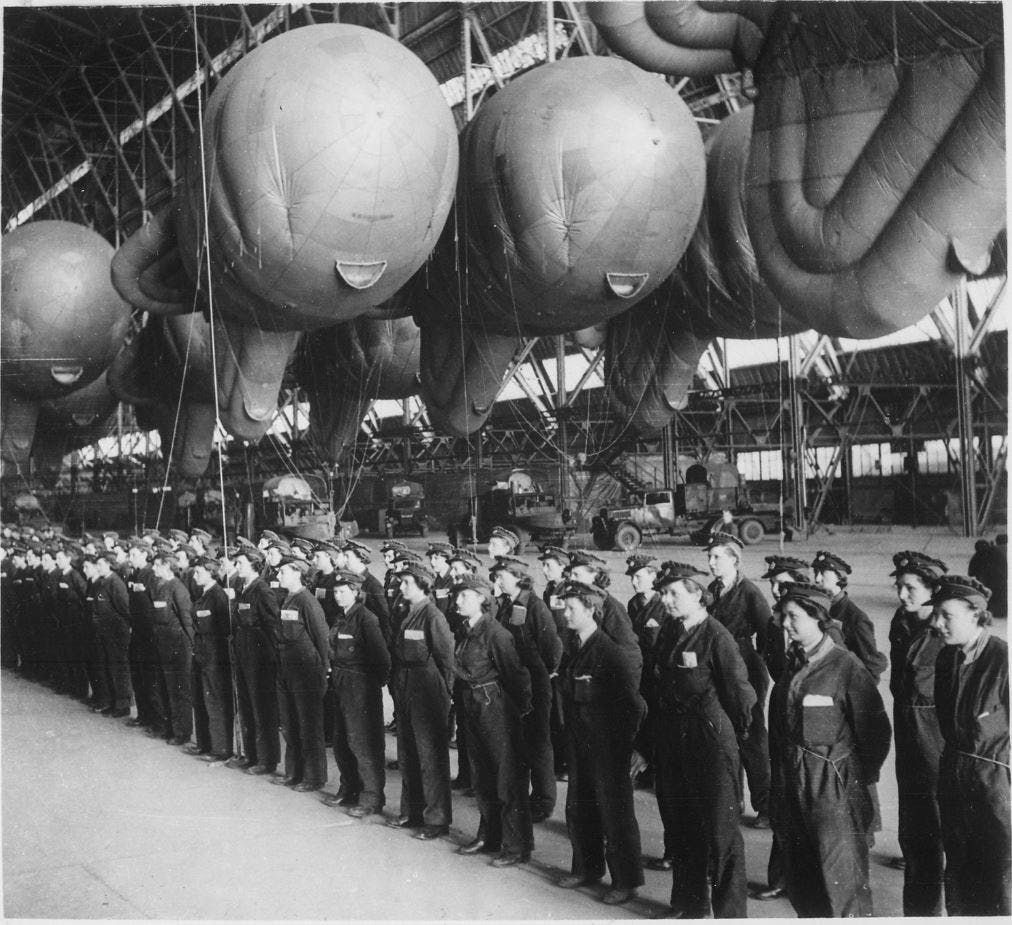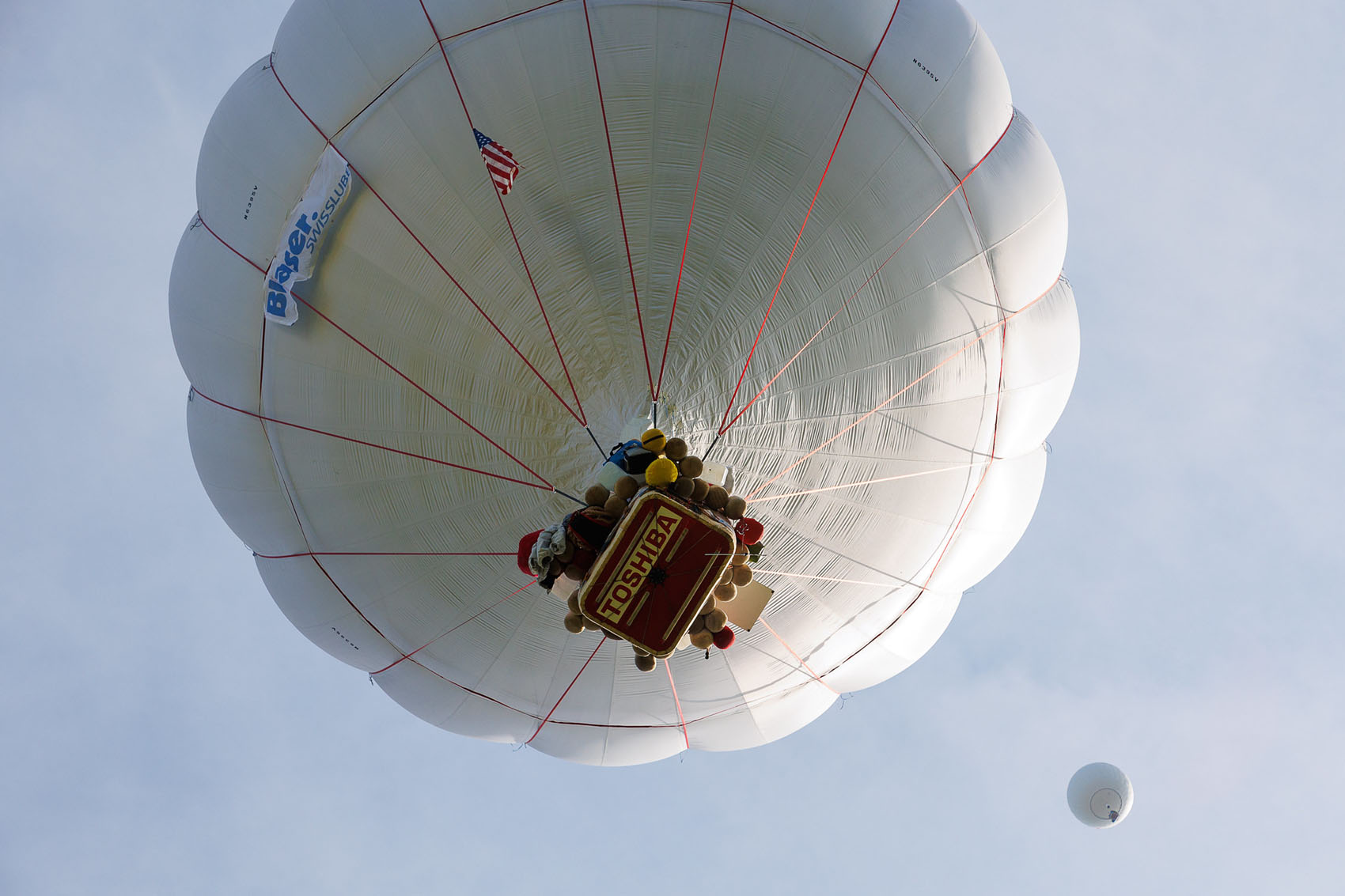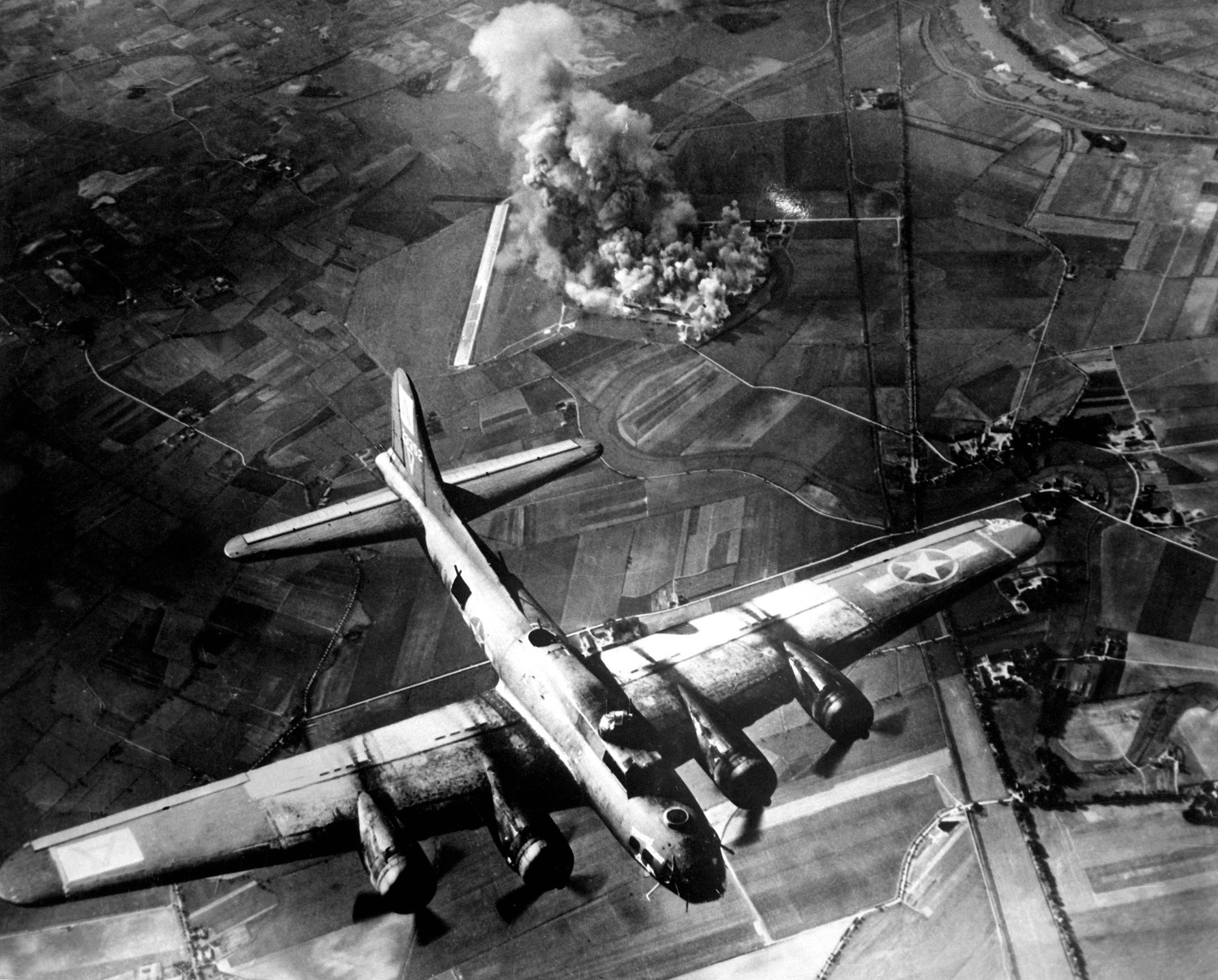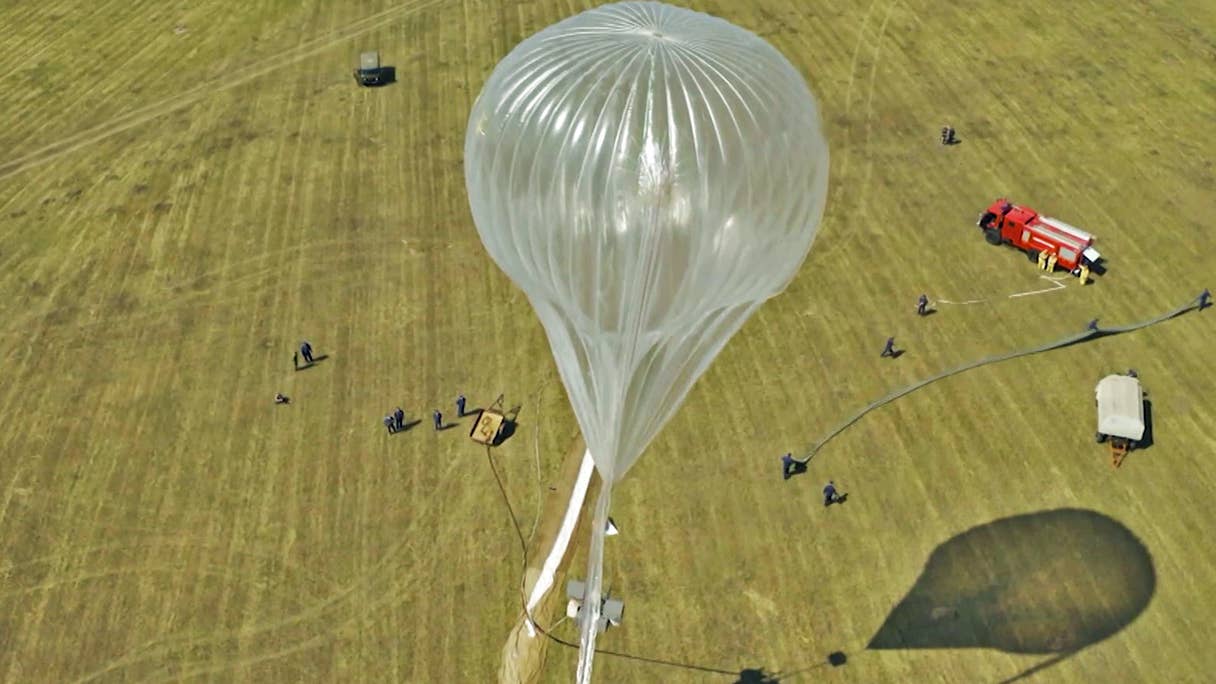Anti Aircraft Balloons - For forces struggling to maintain air supremacy, barrage balloons work. First employed in World War I, barrage balloons were enormously effective in limiting low-level air attacks on defended sites. During World War II, the U.K. deployed about 2,000 balloons, effectively hindering German bombing, aerial sea mining and other low-level flight operations.
After completing training, the 320th Barrage Balloon Battalion boarded ships to England in preparation of the invasion of continental Europe. The 320th were just one of the thousands of units that prepared for the invasion and trained for their specific role.
Anti Aircraft Balloons

The 320th was spread across over 100 landing craft that day destined for the Omaha and Utah beaches, the stretches of French coast assigned to the American military to secure. Barrage balloons were inflated in England and attached to the various ships taking part in the invasion for the trip across the English Channel.
Blimps In War A New Phenomena
As the Pentagon looks to buy innovative weapons for Ukraine, it might do well to explore the humble barrage balloon. Quaint weapons, associated with an old-fashioned way of war, the barrage balloon was simply a gas-filled bag tethered to the ground by a wire.
When employed in numbers, modern balloons can make low-level flight dangerous, forcing attackers to fly higher, exposing themselves to basic air defenses and reducing the effectiveness of low-level bombing runs. Balloons were used as a psychological tool as well.
A balloon release over enemy territory can make an enemy feel extremely vulnerable and vulnerable, which could cause them to act rashly. In the Battle of Britain, the German Air Force launched a series of bombing raids against the United Kingdom, believing that they could penetrate the Royal Air Force's air defenses.
The balloons, on the other hand, acted as a psychological barrier, preventing the bombers from approaching the civilian population. Brahzer balloons are still used as an aerial defense method. In particular, they are used to protect critical infrastructure such as airports and military bases from attacks.
Why Did They Use Small Blimps In Ww?
They are used to create psychological barriers as well as to obstruct enemy airspace. Despite their effectiveness, Western interest in balloon-based defenses deflated quickly after World War II. Balloons are purely defensive systems, and, once the West seized control of the air in World War II, the passive balloons were no longer needed.
The first untethered balloon flight took place on Nov. 21, 1783, with the first military use occurring during the French Revolutionary Wars. A century later during the Franco-Prussian War, the French again deployed observation balloons — and when Prussian troops besieged Paris, they became a vital lifeline out of the encircled city.
Floating barrage balloons over a specific area prevented enemy aircraft from flying close enough to target the area from directly overhead with bombs or strafing fire. If an enemy aircraft was determined to attack, the balloons forced them to fly at higher altitudes (to fly over the balloons) making them more susceptible to larger caliber anti-aircraft gunfire.

The balloons themselves could also destroy enemy aircraft, especially at night: the cables that anchored the balloons to the ground were very difficult to see and posed a risk to any aircraft that flew into them.
An aircraft caught in a cable could be slowed down enough to stall or have a wing torn off. In the early days of World War II, the use of anti-aircraft balloons was widespread. They were used to protect against enemy aircraft and were often used in conjunction with anti-aircraft guns.
The balloons were usually made of metal and were filled with helium or hydrogen. They were tethered to the ground and could rise to a height of several thousand feet. When an enemy aircraft flew into the area, the balloons would be released and would float up to the aircraft, forcing it to fly higher and making it more difficult to hit targets on the ground.
From left to right, PFC Arko Shaw, PFC Alvin Smith, Cpl. Jessie Sumlin, and Pvt. James Shrapshire hauling a barrage balloon through a partially cleared mine field to a new site in France, August 22, 1944. NARA 111-SC-192592
Piloted by balloon busters, they shot down more than five balloons at the same time. They were made of highly woven fabric rather than cheap latex Mylar or latex balloons. Despite the fact that the balloons were only fired at by the British during World War I, they used in-ground illumination rounds to their advantage.
During World War I and World War II, observation balloons were used to direct enemy aircraft over 5,000 feet above sea level, where anti-aircraft artillery was effective. These balloons were difficult to shoot down, as they could ignite in a large fireball and kill the enemy fighter when they fell.
Flying at the things proved to be one of the best ways for top American, English, and French pilots to demonstrate their abilities. He ended up in the water after his wingman was shot down in midair while attempting to take down his fifth balloon.
After passing basic training, the battalions began six weeks of balloon training, where they learned the skills needed to handle barrage balloons in combat. The balloons issued to these troops were known as very low altitude (VLA) balloons, which were about 35 feet in length and operated below 2,000 feet.
They learned how to carefully fill the balloons with over 3,000 cubic feet of inflammable hydrogen gas, preventing sparks or static electricity which could catch them afire. They learned how to camouflage the balloons, repair them, and generally maintain them on the battlefield.

They also learned how to attach and arm a small explosive charge to the cable that anchored the balloons to the ground. If an enemy aircraft struck the cable while flying near the balloons, the cable would snag on the wing and bring the explosive towards the wing, causing it to explode.
Blimps are becoming increasingly common in war, despite their relatively new application. It is possible to use these vehicles in civilian contexts, such as transatlantic travel. During World War I, the biplane was quickly adapted for military purposes, and cables were used to prevent German air attacks.
If a plane strikes the cable, the wing could be ripped off and the plane would crash. This is exactly the sort of low-cost and low-tech innovation Ukraine needs as it struggles to keep contesting airspace over the Donbas region of eastern Ukraine.
With its air force largely absent, Ukrainian defenders need every possible advantage as they concentrate and start pivoting towards the attack. After the First World War ended, the U.S. military decided that it was important to investigate means of defending areas from aerial attack.
In 1923, the United States Army decided to study which anti-aircraft defenses would be most effective to develop. The Army Air Service argued that barrage balloons would be an inexpensive and effective means of protecting strategically important locations, such as the Panama Canal.
The Air Service was given permission to develop barrage balloons for the military. This decision, however, set off an inter-agency feud with the Coast Artillery Corps, which thought that barrage balloons would fit in better with the other anti-aircraft defense items already under their command.
It was eventually decided that the Air Service would be placed in charge of developing barrage balloon technology, but the Coast Artillery Corps would actually operate the balloons. Camp Tyson, Tennessee, became the home of the barrage balloon battalions at the end of 1942 as units that had begun training elsewhere in the U.S.
were moved to the newly built camp. The camp would produce over thirty barrage balloon battalions, including four comprised entirely of African American recruits: the 318th, 319th, 320th, and 321st Barrage Balloon Battalions. Each battalion consisted of 1,100 men and over 50 balloons.
The idea for airships evolved from the Montgolfier brothers' successful first attempt at flying a spherical balloon in 1783. The Friedrichshafen, an aerial navigation technology, was developed in 1908 by Ferdinand Zeppelin. During its first flight, it flew for about 17 minutes at speeds of approximately 3.7 miles per hour and reached a height of 1,300 feet.

When used against enemy aircraft, the balloons resembled phonograph-shaped aircraft carriers. They could be stabilized with metal cables and their shape adjusted to withstand high winds in the event of a storm. If you add barrage balloons to a bow, the balloons could reach heights of 14,766 feet/4,500 meters.
We rely on the generous support of donors, sponsors, members, and other benefactors to share the history and impact of aviation and spaceflight, educate the public, and inspire future generations. With your help, we can continue to preserve and safeguard the world's most comprehensive collection of artifacts representing the great achievements of flight and space exploration.
By countering the mobility of Russian pilots, and forcing them to be both less effective and more exposed to danger, it may be worthwhile to recall this old battlefield tool, and see if it can help Ukraine better protect land assets and keep eastern Ukraine a dangerous
place for Russian aircraft. During World War II, an important part of the Allied deception strategy was the use of inflatable decoys. It is possible that the inflatables will fly over enemy lines and return with intelligence, masking the true state of preparations for the invasion.
The Germans were well aware of the decoys and had been on the lookout for them for some time, but never captured any of them. For their work on Omaha beach, the battalion received a commendation from the Supreme Commander of the Allied Expeditionary Forces in Europe General Dwight D. Eisenhower.
Although their service was unique to the D-Day invasion, they played a critical role in the success of the invasion which would eventually bring an end to German control of Europe. As Allied infantry forces moved further inland from the original invasion beaches, the 320th Barrage Balloon Battalion helped keep the vital artery of supplies open to keep the soldiers fed, armed, and bandaged, and protected both the living and the dead who remained on the Normandy
beaches. Balloons are more than just a physical threat. Balloons force pilots and unmanned aircraft operators to be on constant watch. They can become a psychic burden, making even the most hardened pilot question his or her career choices.
During World War II, the U.S. Navy used blimps to fly convoys through England and the Soviet Union to protect these massive armaments from German U-boats. You may have noticed that the many airships passing over the mighty fleet in the photographs taken at D-Day.
Although the joint command was in the process of developing the barrage balloon units almost from nothing, the Japanese attack on the U.S. fleet in Pearl Harbor on December 7, 1941, brought the barrage balloon program to the forefront.

Following the attack, Chief of the Coast Artillery General Joseph A. Green ordered that every possible effort be made to send three barrage balloon battalions to the west coast to protect important locations including the Bremerton Navy Yard in Bremerton, Washington and the Boeing aircraft plant in
Seattle, Washington. A lack of equipment meant that this task could not be completed until the spring of 1942. The Air Corps and Coastal Artillery Corps would continue to develop new equipment, new balloons, and new techniques.
By the end of 1942, however, what was needed most was new recruits; this is where the story of the 320th Barrage Balloon Battalion begins. Balloons brought down aircraft. During the Battle of Britain, 102 aircraft struck balloon cables, forcing 66 down.
Balloons were particularly effective against the first drone aircraft, accounting for 231 V-1 missile "kills." Tactical doctrine supported rapid balloon movement, and close integration with local air defenses. The 320th Barrage Balloon Battalion served for almost 150 days in France following the invasion.
They continued flying their balloons over the beaches and eventually a portion flew over the port of Cherbourg before the worsening weather in October prevented ships from landing any more supplies. They returned to England, and eventually back to the United States, where it prepared to support the war in the Pacific theater.
The battalion was eventually moved to Hawaii, but the war ended before they entered combat again. Those tactics make sense. Portable air defense systems often rely on the human eyeball to initiate targeting. It takes time to notice an aircraft, point the weapon at the aircraft, track it, and then fire.
By flying low, speedy aircraft are often long-gone before a potential defender has time to spin up a 9K338 Igla or grab a FIM-92 Stinger missile. Once recruits passed balloon training, they ended their time at Camp Tyson with twelve weeks of weather forecasting training.
Controlling the 35-foot balloons in strong winds or bad weather could be incredibly difficult, if not dangerous, so recruits needed to know how to predict what to expect. It was important to have the barrage balloons airborne before night, when it was expected that most enemy aerial attacks would come.
Despite the overwhelming odds against them, the 320th had one balloon aloft over the eastern end of Omaha beach by 11:15 pm on the night of June 6, and would have 12 balloons aloft by dawn the next morning.

These balloons were quickly destroyed by enemy fire, but more balloons were brought ashore, and by the night of June 7, 20 balloons were aloft over Omaha beach, and 13 balloons were aloft over Utah beach.
On Oct. 7, 1870, French interior minister Leon Gambetta left Paris in the balloon Armand-Barbès in order to rally troops near Tours. The last balloon took off from Paris on Jan. 28, 1871, the day of the armistice.
When they are buoyant, balloons and airships rise. Archimedes, a Greek philosopher, laid the groundwork for buoyancy in the 14th century. There are two types of lighter-than-air craft: balloons and airships. Brothers Joseph and Etienne Montgolfier were the first to fly hot air balloons.
Jacques Charles, who invented the hydrogen balloon, discovered it in 1783. Pilatre de Rozier and Pierre Romain were the first to die as a result of being in a balloon. Jean-Pierre Blanchard created a hydrogen balloon that could flap its wings to control its flight.
These passive defensive systems wore on pilot consciousness, and several reports—from both sides in World War II—cited concerns that balloons loomed large as a threat, degrading effectiveness, and posing a disproportionate distraction to pilots and aircrew.
In terms of distance traveled, the Montgolfier hot air balloon surpassed the distance traveled by the Charlire hydrogen balloon. On January 9, 1793, Jean-Pierre Blanchard ascended from the yard of the Washington Prison in Philadelphia, Pennsylvania, as part of his "March of Rebellion."
In 1852, Henri Giffard's steam-powered dirigible chugged for seventeen miles in the air, reaching speeds of five miles per hour. In 1927, a Brazilian named Alberto Santos-Dumont was the first to build and fly a gasoline-powered airship.
The Zeppelin dirigibles were named after Count Ferdinand von Zeppelin, who invented them in 1886. David Schwarz designed and built the first rigid-framed airship, which flew on November 3, 1897. Thomas Baldwin constructed the California Arrow, a 53-foot airship that
won a one-mile race in 1904. In response to the French balloon flights, Alfred Krupp developed a breech-loading 37-millimeter cannon mounted on a pedestal fixed to the bed of a carriage. Some sources describe the gun as a Ballonabwehrkanone or "balloon-defense gun."
If used in numbers in tactically interesting areas, balloons make low-level flying a dangerous exercise. They immediately force attacking aircraft to operate at higher altitudes. And with the Russian Air Force running out of precision weapons and increasingly relying upon "dumb bombs," removing the threat of low-level air attack immediately makes Russian air strikes less accurate.
are hot air balloons aircraft, anti aircraft tank, anti aircraft games, anti aircraft guns, anti aircraft systems